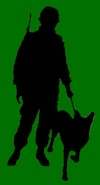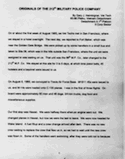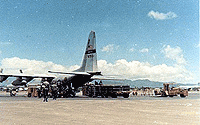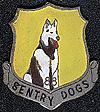720th Military Police Battalion Vietnam History Project |
1965 Vietnam Timeline
|

|
|
To eliminate duplication of materials and information, the Pershing Field HQ Platoon page has been incorporated into this company timeline page. Specific activities relative to it are identified with- HQ Platoon. In addition, all page links, linked photographs and their Email links have been reformatted and updated. The same process, with the exception of some dated photographs (most will still be maintained in their respective detachment pages), has been done with the textual timeline history of all the other 88th and 212th company detachments.
|
If you have any questions about this process please feel free to direct them to the History Project and Website Manager via the Email Link at the top of this page.
|
1965 |
. |
March |
8 March-24 December 1965 |
First U.S. Army K9 Units Assigned to South Vietnam |
July |
Before their call up and reassignment orders, most of the personnel had been previously assigned to security duties at various Army Nike Missile System bases in California and throughout the Continental United States (CONUS). The NIKE (named for the mythical Greek goddess of victory) guided surface-to-air missile system was designed to defend against the threats of the Soviet Union’s newly developed long range bomber aircraft designed to carry conventional nuclear bombs. |
. |
The NIKE bases were developed in rings around major U.S. population centers and other vital targets as a “last ditch” line of defense. As a result of rapidly growing U.S. and Soviet technology in the development of International Continental Ballistic Missile’s, the NIKE program became less critical and in the 1960’s many began the process of being phased out as their funding was shifted to other defensive priorities, including the Vietnam War. |
. |
A mix of newly trained and experienced Army K9 unit personnel assigned to NIKE site Army K9 security units in California, with fillers to bring their units up to TO&E from NIKE bases throughout CONUS, began receiving reassignment orders for transport to a transit facility cantonment just outside of Berkley, California where they awaited further movement orders. |
23 July Under Letter Order 7-6, issued by Headquarters, 6th Region, United States Army Air Defense Command at Fort Baker, California, Subject: Movement-Permanent Change of Station of ORG/Units with a ready date of 3 August 1965, the 71st MP Detachment (Dog Platoon HQ) 1 officer and 1 enlisted man, 209th MP Detachment (Dog Platoon HQ) 1 officer and 1 enlisted man, 221st MP Detachment (Dog Platoon HQ) 1 officer and 1 enlisted man, 72nd MP Detachment (Dismounted Patrol) 140 enlisted men, 26th MP Detachment (Supervisor) 28 enlisted men, 45th MP Detachment (Animal Care) 8 enlisted men, all of Tilden Park, Berkely, California, consisting of 92 personnel.
|
The 212th MP Company (Sentry Dog) "The Originials" The collective reflections of SP/4 Paul D. Fowler, SP/4 Aaron F. Helmick, SP/4 Julian J. Gabica, SP/4 Willis E. Wass, SP/4 Leroy J. LaVigne and SP/4 Gary J. Heimbigner. Courtesy of SP/4 Gary J. Heimbigner, 88th MP Company (K9) MACV & 212th MP Company (Sentry Dog), 89th MP Group, Vietnam, 1965-1966 |
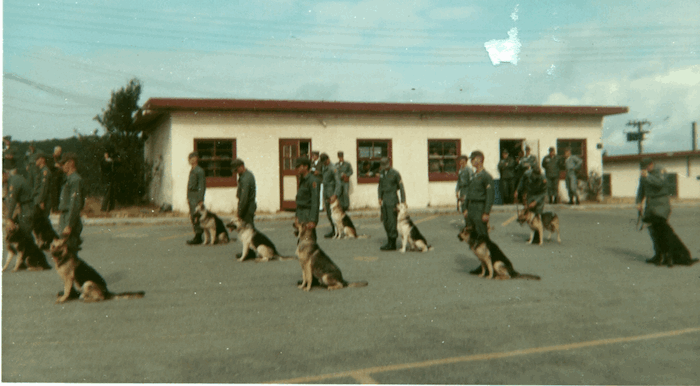 |
Photo G3656: Handlers & K9’s of the 71st MP Detachment (Dog Platoon HQ), 209th MP Detachment (Dog Platoon HQ), 221st MP Detachment (Dog Platoon HQ), 72nd MP Detachment, (Dismounted Patrol), 26th MP Detachment (Supervisory) and 45th MP Detachment (Animal Care) unit, soon to be the 88th MP Company (K9) standing formation in the detachment area (Site 09) of the old Nike Missile Base in the Tilden Park area near Berkley, CA before their deployment to Travis Air Force Base and flights to Saigon, Vietnam in August 1965. Courtesy of SP/4 Gary J. Heimbigner, 88th MP Company (K9) MACV & 212th MP Company (Sentry Dog), 89th MP Group, Vietnam, 1965-1966.
|
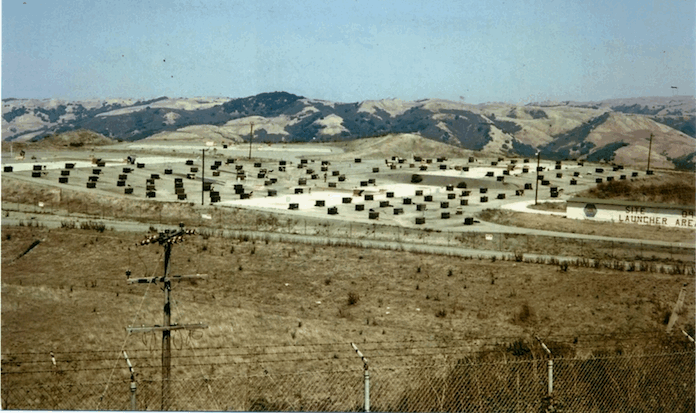 |
Photo G3657: K9 staging area for the Handlers & K9’s of the 71st MP Detachment (Dog Platoon HQ), 209th MP Detachment (Dog Platoon HQ), 221st MP Detachment (Dog Platoon HQ), 72nd MP Detachment, (Dismounted Patrol), 26th MP Detachment and 45th MP Detachment (Animal Care) units, soon to be the 88th MP Company (K9) in the detachment area (Site 09) of the old Nike Missile Base in the Tilden Park area near Berkley, CA before their deployment to Travis Air Force Base and flights to Saigon, Vietnam in August 1965. Courtesy of SP/4 Gary J. Heimbigner, 88th MP Company (K9) MACV & 212th MP Company (Sentry Dog), 89th MP Group, Vietnam, 1965-1966.
|
88th MP Company (K9) |
Pershing Field Compound, Tan Son Nhut Air Force Base, Saigon |
August |
The component detachments were flown to Vietnam in a group flight of several C-130’s landing at Tan Son Nhut Air Force Base in Saigon (on or about 6 August), Capital Military District, Gia Dinh Province, III Corps Tactical Zone and assigned subordinate to the Military Assistance Command Vietnam (MACV) Headquarters on Tan Son Nhut Airfield, Saigon for all purposes. Their initial headquarters cantonment was set up in the airfield's Pershing Field (Tent City) compound. |
|
The component groups Tent City compound was an appropriate description; there were no billets, motor pool, kennels, mess hall or anything resembling a permanent base footprint. For most of the incoming military police units temporarily headquartered in Tent City awaiting further deployment and assignment, their tour in Vietnam started out as one long bivouac. |
When interviewed years later, many of the veterans said that after they arrived in Vietnam they had the distinct impression that MACV was unprepared for their arrival, and that no one knew what to do with them or where to send them. |
. |
Upon finally reaching operational status with an organic command structure as the 88th MP Company (K9), they were formed into several small groups (the exact component percentages unknown), and prepared for further deployment throughout South Vietnam. |
. |
The Headquarters Platoon 88th MP Company (K9) remained at the Pershing Field compound under the operational control of Headquarters Military Assistance Command Vietnam (MACV). |
. |
Editors Notes: The term "Originals" was not an official historical name of the company, its use comes from the pride of being the first U.S. Army sentry dog handlers deployed to Vietnam by the members of the "original" multiple detachments that first arrived from Tilden, California. |
Tent City was an appropriate description; there were no billets, motor pool, kennels, mess hall or anything resembling a permanent base footprint. For most of the incoming military police units temporarily headquartered in Tent City awaiting further deployment and assignment, their tour in Vietnam started out as one long bivouac. |
|
Personal Reflections "When we arrived, we were the 71st MP Platoon, and then shortly after that we became the 72nd MP Detachment Dismounted Patrol, then we were designated the 88th MP Company (K9). I can remember all the units that are on the orders became the 212th, about 5 or 6 months after we arrived in Vietnam." SP/4 Dan Byrd, 88th MP Company (K9), Military Assistance Command Vietnam (MACV) & 212th MP Company (Sentry Dog), 95th MP Battalion, 89th MP Group, 18th MP Brigade, August 1965 to August 1966. "I was on the first plane load of Army Dogs and handlers to go over, in fact I was on the first plane load that landed. We flew over from Travis Air Force Base, California on C-130's, around the 4th or 5th of August 1965. I believe there were three planes with 144 handlers and their K9's. We stopped at Midway Island, Hawaii, Japan and Guam. One of the planes developed engine trouble in Hawaii so we had a layover there for several hours until it was fixed. |
. |
|
My plane carried dogs, their food, handlers, our duffel bags and gear, and a 3/4 ton truck. I sat in the truck all the way over. We landed at night at Tan Son Nhut [airbase] and stayed there about a week, and we were shipped out from there." SP/4 Dan Byrd, 88th (K9), MACV & 212th MP Company (Sentry Dog), 89th MP Group, MACV, & 95th MP Battalion, 89th MP Group, 18th MP Brigade, August 1965 to August 1966. |
Personal Reflections "I was in the first element to leave Tilden Park, California, which was the gathering place for all the handlers going to Viet Nam. We flew out of Travis Air Force Base California on a C-130 Hercules, with a bunch of handlers, dogs in shipping crates, all our supplies, and a 3/4 ton truck in the plane. It was a long trip to Viet Nam. If I remember correctly we made stops in Hawaii, and Guam to refuel. The inside of the plane smelled pretty rank by the time we got to Viet Nam. We stayed in a tent city in Saigon for quite awhile before getting shipped out to our prospective duty stations." SP/4 Robert C. Gitchell, 88th MP Company (K9), MACV & 212th MP Company (Sentry Dog), 89th MP Group, MACV, & 95th MP Battalion, 89th MP Group, 18th MP Brigade, 1965-1966. |
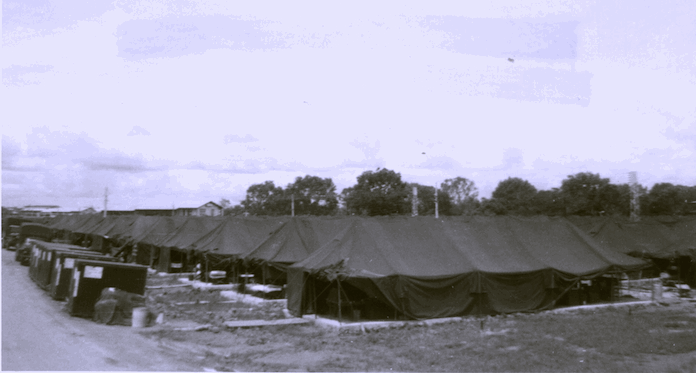 |
Photo G3658 The 88th MP Company (K9) quarters in Tent City B area of Pershing Field, Tan Son Nhut Airbase, Saigon, Vietnam in September 1965. Courtesy of SP/4 Gary J. Heimbigner, 88th MP Company (K9) MACV & 212th MP Company (Sentry Dog), 89th MP Group, Vietnam, 1965-1966.
|
. |
Soc Trang Detachment, Personal Reflections "We flew out of Saigon for Soc Trang on a Caribou, twin-engine cargo plane. Living arrangements were pretty damn crude at Soc Trang when we got there. About half way thru my tour I got promoted to SP/4, and moved to Can Tho airfield as assistant detachment leader, and stayed there until the end of my first of three tours in Viet Nam. " SP/4 Robert C. Gitchell, 88th MP Company (K9), MACV & 212th MP Company (Sentry Dog), 89th MP Group, MACV, & 95th MP Battalion, 89th MP Group, 18th MP Brigade, 1965-1966. |
Vung Tau Detachment The 88th MP Company (K9) also staffed a detachment in Vung Tau of approximately 18 to 20 teams commanded by a Sergeant. Before the formal kennels were constructed the K9's lived in command tents with sand floors. The unit also ate C Rations until permanent mess facilities could be arranged. |
Vung Tau Detachment, Personal Reflection “I was a Private First Class (draftee) in the Army from 1963-1965, and in 1965 I was stationed at a Nike/Hercules Missile base in Chesterton, Indiana when I received orders for Vietnam. My orders assigned me to the 72nd MP Detachment (Dismounted Patrol). My partner PFC Robert Ahrendt and his dog Lady were also shipped out at the same time (sometime in early 1965). I was close to the end of my service commitment (October 1965) so I never could figure out why they sent me with so little time remaining. |
. |
We did some training outside San Francisco prior to going. It was located up on some mountain at an old military base as I remember it. It was a closed base they opened just for us. We used to take a school bus down the mountain and over the bridge. |
. |
After a short training period we were loaded on twin-engine cargo planes for the trip to Vietnam. We went over in some twin-engine cargo planes, like C121 or something like that. I was nervous going over the ocean with a full plane and only two engines. I remember that one of the planes (not mine) lost an engine on the way so we had to stop somewhere (can't remember where). As I remember it we had 76 dogs and men to a plane. The dogs were stacked three high in their aluminum kennels, and we made multiple stops on the trip to Vietnam. |
. |
We landed in Saigon in the middle of the night, unloaded and went to our main base where everyone was located. We spent some time doing duty in Saigon, ranging from warehouse and waterfront security, to even street patrols (without dogs). Our kennels were just tents with stakes in the ground to chain the dogs during non-duty hours. Shortly after our arrival we became the 88th MP Company (K9). |
. |
Subsequently we were split up into smaller groups. I believe my group had about 10 to 12 handler teams, but can’t be certain. We were sent to a place outside a village called Vung Tau where some Delta River’s and South China Sea met." PFC Arthur “Art” K. Przybyl, 72nd MP Detachment (Dismounted Patrol) & 88th MP Company (K9), MACV, August-November 1965. |
. |
|
Saigon Docks Detachment According to PFC Arthur K. Przybyl of the 72nd MP Detachment, upon their arrival in Vietnam some of the members were assigned to dismounted patrol on the piers and wharves of the Saigon Docks where cargo arrived and was subject to high theft rates. However, only a few of the handlers did that- mainly SP/4 level and higher. |
September |
Tan Son Nhut Air Force Base Detachment, Personal Reflection “Me and my dog King (234E) shipped to Oakland, California in August of 1965. We were part of a group of fifty dogs and handlers going to Vietnam. We stayed for about two weeks in an old missile site back in the hills outside Oakland then shipped out one night on a C130. Upon arrival in Vietnam and after about a week in Tent City I was assigned to C Battery, 6th Battalion, 56th Artillery. I stayed in the same unit for 12 months. |
. |
The Detachment consisted of four Handler-K9 teams, providing battery perimeter around the HAWK systems during the evening hours. The nighttime security involved one team from dusk until midnight, being relieved by a second team who worked till dawn. The battery personnel provided the daytime security for the site. |
. |
The detachment had responsibility for a short portion of a shared perimeter near the flight line with the Air Force Security Polices (AP) K9 Sentry Dog units, but the dogs would alert on each other so we kept our distance whenever possible. An AP handler fired on me one night, he was new in-country, and scared.” SP/4 Eddie Hall, 88th MP Company (K9), MACV & 212th MP Company (Sentry Dog), September 1965-September 1966. |
. |
The number and location of the other 88th MP Company (K9) remote deployments has not been found in currently available records. However, it is believed they were the same as listed in the 1966 Timeline for 17 January. |
Being the first Army K9 Sentry Dog unit in South Vietnam also came with the responsibility of improving their own quarters and kennels for their K9's under the Army’s Self Help (construction) Program. Living conditions remained Spartan at best, and there were many lessons yet to be learned. |
HQ Platoon The members of the 88th headquarters platoon that were not deployed to remote sentry dog duty stations spent their stay working with members of the 557th MP Company (Guard), 91st MP Detachment (Confinement Facility) and 148th MP Platoon (Dismounted Patrol), all three subordinate to the 95th MP Battalion, 89th MP Group, MACV. |
As a group in their spare time they dug ditches, laying “potable” water pipes from the Bravo Compound to Pershing Field for shower facilities, poured and finished cement pads for their personnel tents. Portable generators were procured to provide electrical power for their lighting, telephone lines and base radios. All of these operational necessities were constantly maintained by the unit personnel who were turning the field of tents into a fast growing community under the most trying and adverse conditions. |
. |
December |
. |
25 December 1965-30 June 1966 |
Use Your Browser Button To Return
|
